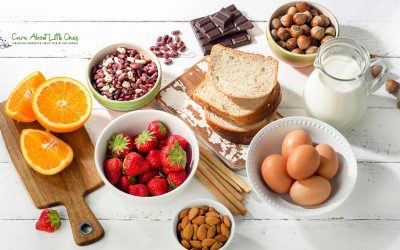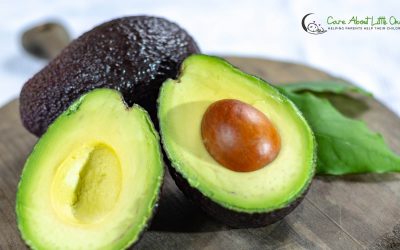Best First Baby Foods To Avoid Digestive Issues (4-24 Months)

Table Of Contents
Why You Should Ignore All Baby Weaning Guides Out There
1 Be Aware Of The Sugar Content Of First Baby Foods
2 Choose First Baby Foods Based On Their Impact On Your Baby’s Body Temperature
3 Choose First Baby Foods Which Support Your Baby’s Digestive System
Best First Baby Foods For Babies Up To 9 Months Of Age
Best First Baby Foods For Babies Between 9 And 12 Months Of Age
Best First Baby Foods For Babies Between 13 And 24 Months Of Age
When parents approach me to hear my advice on best first baby foods, they are often surprised that that advice fundamentally differs from what they have heard or read elsewhere. However, given the fact that the digestive system of a baby is only just developing, some foods are just not appropriate for certain age ranges.
So, what are the then best first baby foods? In brief, the best first baby foods are the ones which
- do not contain lots of sugar
- do not have too much of an impact on your baby’s body temperature
- support your baby’s digestive system.
This blogpost serves as a guide on how to choose first baby foods. It also includes a list of the best first baby foods for up to 24 months of age. Moreover, I explain why you should consider the impact of different kinds of food on the baby’s body temperature. And finally, I tell you exactly which foods will not only fill your baby’s stomach, but even support your baby’s digestive system.
Why You Should Ignore All Baby Weaning Guides Out There
Type in “best first baby foods” in Google and you will find hundreds of guides on supposedly best first baby foods for weaning. At first sight, you may think that those guides are super helpful. But really, they are not!
I looked at 15 random guides. Each one of them included a list of recommended foods with fruits ranking at the top of the list. Among them, such popular fruits like apples, bananas, mango and pears.
Now basically, there is nothing wrong with feeding a baby fruits – even as a first food. Moreover, I do understand that fruits like banana are particularly tempting due to their soft consistency.
However, it is all about the right selection of fruits. And frankly, there is much more to it than choosing first baby foods according to a food’s consistency.
In fact, when it comes to choosing the right kinds of first baby foods to avoid digestive issues, I recommend considering three things:
1 Be Aware Of The Sugar Content Of First Baby Foods!
The truth is: most fruits contain lots of sugar. And although they are usually a way better alternative than fruit juice, they can still cause lots of troubles for your baby’s digestive system.
Fructose, for instance, which is a form of sugar contained in fruits, can be particularly difficult for your baby’s intestines to absorb. Non-absorbed carbohydrates present a so-called “osmotic load” to the gastrointestinal tract which quickly trigger bowel movements (1).
The problem is that if carbohydrates are malabsorbed in the small intestines, they are subsequently fermented by bacteria in the colon, resulting in gas and bloating (1; 2). Sometimes, this can even cause diarrhea.
Unfortunately, the most popular first baby foods, banana, apples and pears, contain particularly high amounts of fructose. So, don’t be surprised if your baby suffers from bloating, tummy aches and maybe even diarrhea.
Oh, and by the way: fruit puree from baby food pouches which have come up in recent years, are not any better. Parents are lured into believing that they feed their baby healthy first foods in pureed form. In fact, those pouches can do more harm than good, because many of them contain amounts of sugar, which are just not appropriate given the immaturity of a baby’s digestive system.
2 Choose First Baby Foods Based On Their Impact On Your Baby’s Body Temperature!
One does not need to be a doctor to know that ice-cold water can cool down your baby’s body. Chili, on the other hand, can increase your baby’s body temperature and make her sweat. Logically, you would neither feed a baby ice-cold water, nor chilis.
So, in a way, you are concerned about the energy (heat or coldness) that those drinks or foods release in your baby’s body.
However, what you need to understand is that each and every food releases a similar energy in the body, even when their actual temperature is neither hot nor cold.
Chili, for instance, does usually not feel particularly hot if you touch it. However, swallow it and you will be surprised about the intense heat that they release inside your body!
Mint is another example. It is a popular herb to be used in drinks on a hot summer day.
It’s not that mint itself would be particularly cold if you touch it. Yet, mint can cool down the body. The same applies to mint tea, although tea is usually consumed as a hot beverage.
The truth is: foods that we eat have various effects on our body temperature. Some cool the body down, some heat it up. And some foods have no effect at all.
Unfortunately, in Western societies, people are not used to that way of thinking. In many Eastern countries, however, foods are being classified according to their temperature. And by “temperature”, I do not mean the actual temperature of the food. Instead, I mean the energy (heat or coldness) that they release in the body.
Here are the five classes of foods based on their temperature according to Traditional Chinese Medicine (3, 4, 5, 6, 7):
Cold Foods
Such foods have a particularly strong cooling effect on the body.
Examples:
Banana, clams, crab, grapefruit, lettuce, star fruit, salt, tofu, water chestnut, watercress, watermelon, and many more.
Cool Foods
Such foods have a moderate cooling effect on the body.
Examples:
Apple, asparagus, barley, broccoli, button mushrooms, cucumber, egg white, kiwi, lemon, mango, mushrooms, orange, pear, peppermint, strawberry, tomato, mung beans, spinach, soybean, and many more.
Neutral Foods
Such foods have no or almost no effect on the temperature of the body.
Examples:
Apricot, beetroot, cabbage, carrot, cashew nuts, cheese, duck, egg, egg yolk, figs, grapes, goose, honey, milk, mussels, potato, white sugar, papaya, peas, pork, olives, peanuts, pineapple, plums, sweet potato, shiitake mushrooms, turnips, and many more.
Warm Foods
Such foods have a moderate warming effect on the body.
Examples:
Beef, cherry, chestnut, chicken, chives, cinnamon, dates, clove, coriander, cumin, fennel, garlic, green onion, ham, jasmine, leeks, lobster, nutmeg, onion, peach, pine nut, prawns, pumpkin, raspberry, rosemary, spring onions, walnuts, and many more.
Hot Foods
Such foods have a particularly strong warming effect on the body. They can cause heat in the body.
Examples:
Cayenne pepper, chili pepper, ginger, pepper, and many more.
Just to make things clear! The foods that I mention above are just examples of foods with different kinds of effects on the body’s temperature. These are not the foods that I recommend as first baby foods!
So, How Is This Relevant For This Blog Post?
A baby’s digestive system is quite weak initially. Introducing solids is a major step in her development but also a great challenge for the digestive system. Putting her on a diet which is overly cold in nature can put an even heavier burden on her digestive system.
And just like extreme cold slows down movements in the nature, cold or cool foods slow down the movements in your baby’s body. Digestion-wise, such a diet can slow down the transportation of stools and cause constipation. (3)
Conversely, putting your baby on a diet with overly warm or even hot foods can be harmful too. Just like heat dries up water in the nature, hot or warm foods can dry up fluids in the baby’s body. Digestion-wise, such a diet can dry out stools and cause constipation, bloating and sometimes the opposite: diarrhea.
So, the key here is to find the right balance between cold and warm foods. And initially, for the very first baby foods, an even better way is to feed your baby foods which have no impact on her body’s temperature at all.
Don’t worry, we’ll have a look at recommended foods later on!
3 Choose First Baby Foods Which Support Your Baby’s Digestive System!
Have you ever had digestive bitters to support your digestion, for example, after a 5-course dinner on Christmas eve? Digestive bitters trigger the production of digestive juices like stomach acid, in order to improve digestion.
Note that, interestingly, the trigger here is the bitter flavor itself! Nothing else.
This means that we can (positively) influence the functioning of certain organs by supporting them with the right kinds of flavor. That way of thinking is used by many alternative health practitioners to help improve the functioning of organs and whole organ systems.
In fact, in Traditional Chinese Medicine, foods are also classified according to their flavor. Choosing the right flavor is supposed to send the nutrients to the corresponding organs. Doing so nurtures those organs so that they can function properly.
However, the idea here is not to feed your baby overly bitter foods to promote digestive juices. Instead, we want to use flavor to support the very basis of her digestive system: her spleen and her stomach. If that basis is strong, the baby is less likely to develop gastrointestinal problems, like constipation.
In order to accomplish that, the diet of a baby during the first 24 months of her life should include foods which are sweet in nature. But keep in mind: sweet does not mean sugary!
Here is a list of foods with different flavors and which organ they nourish according to Traditional Chinese Medicine (4, 5, 6, 7, 8):
Supported Organs: Stomach, Spleen
Example Foods: Fresh ginger, onion, leeks, green onion, Sichuan peppercorn, garlic, celeriac, coriander, Chinese chives, fennel, spearmint, Chinese radish, radish leaf, chili pepper, sweet peppers, turnips, taro, leaf mustard, Shanghai cabbage, cinnamon, tangerine peel, kumquat, mustard seed and wine.
Example Foods: Lemon, tomatoes, pineapple, apple, strawberry, papaya, pears, loquat fruit, oranges, tangerines, peaches, hawthorn fruit, olives, pomegranate, plums, pomelo, mango, grapes, vinegar and royal jelly.
Example Foods: Bitter gourd, Indian lettuce, wine, vinegar, lotus leaf, tea leaf, turnips, apricot seed, lily bulb, gingko, plum kernel, peach kernel, seaweed, pig’s liver, bergamot, arrowhead, asparagus, wild cucumber and coffee.
Example Foods: Amaranths, millet, barley, laver, preserved jellyfish, seaweed, kelp, sea clams, sea shrimps, oyster, crabs, sea cucumber, field snail, pork, pig’s bone marrow, pig’s blood, pig’s organs, razor clam, dried mussel, ham, pigeon’s egg, abalone, duck meat and cuttlefish.
Example Foods: Fresh ginger, onion, leeks, green onion, Sichuan peppercorn, garlic, celery, coriander, Chinese chives, fennel, spearmint, Chinese radish, radish leaf, chili pepper, sweet peppers, turnips, taro, leaf mustard, Shanghai cabbage, cinnamon, tangerine peel, kumquat, mustard seed and wine.
Just to make things clear! The foods that I mention above are just examples of foods which have an effect on certain organs based on their flavor. These are not the foods that I recommend as first baby foods!
So, with these 3 things in mind (low in sugar, temperature effect and the effect of flavor), let’s have a look at what ideal diet plans for babies are supposed to look like:
Best First Baby Foods For Babies Up To 9 Months Of Age
- Taro (0.4g sugar; neutral and sweet)
- Winter Squash (2.2g sugar; neutral to warm, sweet)
- Turnips (3.8g sugar; neutral and sweet)
- Sweet potatoes (4.2g sugar; neutral and sweet)
- Carrots (4.7g sugar; neutral and sweet)
- Parsnips (4.8g sugar; neutral to warm and sweet)
- Peas (5.7g sugar; neutral and sweet)
*In brackets: sugar content per 100g (8, 9); temperature effect and flavor
- Papaya (7.8g sugar; neutral and sweet)
*In brackets: sugar content per 100g (8, 9); temperature effect and flavor
Ideal “Food Temperature”, Flavor And Sugar Content
Temperature
At that age, your baby’s diet should consist of neutral foods in the first place (“neutral” refers to a food’s impact on the baby’s body temperature).
Of course, it will not always be possible to restrict a baby’s diet to neutral foods only.
That’s okay!
The idea here is not to put your baby on an exaggeratedly strict diet. The idea is to avoid a diet which is overly cool or warm in nature (again, the terms “cool” and “warm” refer to a food’s impact on the baby’s body temperature). This will help avoid gastroinestinal issues which typically come from such diets.
With that said, foods that should be avoided in any case are “cold” and “hot” foods according to the table which I have introduced earlier in this blog post!
Such foods can have a strong adverse effect on the digestive system of a baby. In fact, in my experience, they are one of the main reasons, why babies that age often suffer from abdominal pain and bloating.
Flavor
Also, feed your baby primarily foods with a sweet flavor! As mentioned above, this will help support the baby’s digestive system by strengthening her spleen and stomach.
Sugar content
Finally, please consider the sugar content of first baby foods! Avoid foods which contain too much sugar, because the baby might not be able to digest it properly! For your convenience, I have added the sugar content of each food per 100g in the table.
In general
Please note that the list above includes the best first baby foods to avoid gastroinestinal issues. It does not mean that you cannot feed your baby additional foods which are not on the list. However, such foods may simply not be “ideal” given your baby’s age.
Food Preparation
When it comes to the vegetables on the list, make sure that you either steam or cook them, because raw foods are very difficult for your baby to digest. Steaming is preferred, because it preserves the nutrients of the food. Once cooked or steamed, mash the veggies before you feed them your baby!
Fruit-wise, at that age, the recommended fruit is papaya. It is both, neutral and sweet in nature. Moreover, it’s sugar content is moderate compared to other fruits.
You can find a recipe on how to prepare payapa puree in the recipe section!
Best First Baby Foods For Babies Between 9 And 12 Months Of Age
Everything from the list for babies up to 9 months, plus the following:
- Spinach (0.4g sugar; cool and sweet)
- Kale (1g sugar; warm and sweet)
- Broccoli (1.7g sugar; cool and sweet)
- Radish (1.9g sugar; cool and sweet)
- Beans (2.1g sugar; neutral and sweet)
- Cabbage Savoy (2.3g sugar; neutral and sweet)
- Zucchini (2.5g sugar; cool and sweet)
- Pumpkin (2.8g sugar; warm and sweet)
- Cabbage Red (3.8g sugar; neutral and sweet)
- Leek (3.9g sugar; warm and sweet)
- Beets (6.7g sugar; neutral and sweet)
*In brackets: sugar content per 100g (8, 9); temperature effect and flavor
Everything from the list for babies up to 9 months, plus the following:
- Avocado (0.3g – 2.5g sugar; cool and sweet)
- Raspberry (4.4g sugar; warm and sweet)
- Strawberry (4.6g sugar; cool and sweet)
- Blackberry (4.9g sugar; warm and sweet)
- Wild Alaskan Blueberry (6.5g sugar; cool and sweet & sour)
- Peach (8.4g sugar; warm and sweet)
- Pears (9.8g sugar; cool and sweet)
- Apples (10.0g sugar; cool and sweet)
*In brackets: sugar content per 100g (8, 9); temperature effect and flavor
- Quinoa (0.8g sugar; warm and sweet)
- Oats (1.5g sugar; warm and sweet)
- Rice (sugar content depends on the kind of rice; neutral and sweet)
*In brackets: sugar content per 100g (8, 9); temperature effect and flavor
- Chicken (warm and sweet)
- Beef (warm and sweet)
*In brackets: temperature effect and flavor
- Cheese (neutral and sweet)
*In brackets: temperature effect and flavor
Ideal “Food Temperature”, Flavor And Sugar Content
Temperature
We have seen that up to the age of 9 months, a baby’s diet should be based on “neutral” foods in the first place (“neutral” refers to a food’s impact on the baby’s body temperature).
From the age of approximately 9 months, it is still advisable to primarily focus on foods which have a neutral effect. However, at that age, it is also okay to include foods which have a cooling or warming effect too.
When you do, try to combine them to maintain the overall balance. For example, you could combine 2 ounces of a cool food and 2 ounces of a warm food.
Moreover, foods that should still be avoided in any case are “cold” and “hot” foods according to the table which I have introduced earlier in this blog post!
Such foods can have a strong adverse effect on the digestive system of a baby. In fact, in my experience, they are one of the main reasons, why babies that age often suffer from abdominal pain and bloating.
Flavor
Although your baby can eat foods of any flavor, it would be beneficial to focus on foods which are sweet in nature.
As mentioned above, this will help support the baby’s digestive system by strengthening her spleen and stomach. And really, that’s what we want to achieve: help the body build a strong digestive foundation.
Sugar content
Finally, please consider the sugar content of first baby foods! Avoid foods which contain too much sugar, because the baby might not be able to digest it properly! For your convenience, I have added the sugar content of each food per 100g in the table.
In general
Please note that the list above includes the best first baby foods to avoid gastroinestinal issues. It does not mean that you cannot feed your baby additional foods which are not on the list. However, such foods may simply not be “ideal” given your baby’s age.
Food Preparation
In general, please prepare the foods according to the chewing capabilities of your baby! And do keep in mind that your baby could choke on food!
As for the vegetables on the list, they should be steamed or cooked before you feed them your little one. That’s because raw vegetables are quite a burden for the baby’s digestive system. They can easily cause gastrointestinal issues, like bloating.
Steaming is preferred, because it preserves the nutrients of the food.
Fruits can be served raw. But they too need to be prepared according to the chewing capabilites of your little one!
Best First Baby Foods For Babies Between 13 And 24 Months Of Age
Everything from the list for babies up to 12 months, plus the following:
- Cucumber (1.7g sugar; cool and sweet)
- Lettuce (1.9g sugar; cold and bitter)
- Tomatoes (2.6g sugar; cold, sweet & sour)
- Water chestnut (3.8g sugar; cold and sweet)
*In brackets: sugar content per 100g (8, 9); temperature effect and flavor
Everything from the list for babies up to 12 months, plus the following:
- Watermelon (6.2g sugar; cold and sweet)
- Kiwi (9g sugar; cool, sweet & sour)
- Banana (12g sugar; cold and sweet)
*In brackets: sugar content per 100g (8, 9); temperature effect and flavor
- Fish in general (neutral and sweet)
- Tuna (neutral and sweet)
- Herring (neutral and sweet)
- Salmon (warm and sweet)
- Trout (hot and sour)
*In brackets: temperature effect and flavor
Everything from the list for babies up to 12 months, plus the following:
- Pork (neutral and sweet)
*In brackets: temperature effect and flavor
- Tofu (cold and sweet)
*In brackets: temperature effect and flavor
Ideal “Food Temperature”, Flavor And Sugar Content
Temperature
At the age of 13+ months, your baby’s intestines are already capable to digest all kinds of foods. Nevertheless, the goal should be to continue strengthening the baby’s digestive system over the next 12 months.
Because of that, it is still advisable to primarily feed your baby foods which are neutral in their effect.
It is also okay to include foods with a warming or cooling effect (remember, the terms “neutral”, “warming” and “cooling” refer to the effect of a food on the temperature of the baby’s body).
However, if possible, try to maintain the balance! For example, you could combine 2 ounces of cool food with 2 ounces of warm food.
Now, from 12 months on, if you must, you can also introduce foods which have a cold or hot effect on the baby’s body.
However, please keep the amounts of such foods at a minimum!
In my experience, a cold or hot diet can even throw a mature digestive system off balance. Let alone, the immature digestive system of a little baby. They can cause gastrointestinal problems like constipation and are to be avoided in general.
A particular problem is the combination of cold and hot foods. So, while it can be beneficial to combine cool and warm foods, the same does not apply to combining cold and hot foods. This can cause a phenomenon called “empty heat”, which can cause severe gastroinestinal problems.
Some schools in Traditional Chinese Medicine will even tell you to avoid cold and hot foods in general (i.e. all your life). However, in Western socities this is simply not realistic.
As you can see on the list above, cold foods include such popular foods like bananas, kiwi, tomatoes and cucumber. Hot foods, on the other hand, include foods like chocolate, candies, pizza, chips and fries, as well as foods cooked under direct fire (f.e. barbecued, grilled, bakes foods).
Being a mother myself, I know that it is far from realistic to deny a child such kinds of foods.
Therefore, try your best to avoid them during the first 12 months of your baby’s life! You can introduce them slowly thereafter, however, they should only just be a small part of a much more varied diet.
Flavor
Flavor-wise, your baby can have foods of any flavor. Nevertheless, it is beneficial to include as many foods with a sweet flavor as possible (see list above).
As mentioned above, this will help support the baby’s digestive system by strengthening her spleen and stomach. And really, this is what we want to achieve: to further strengthen the baby’s digestive system over the next 12 months.
Sugar content
Finally, please consider the sugar content of first baby foods! Avoid foods which contain too much sugar, because the baby might not be able to digest it properly! For your convenience, I have added the sugar content of each food per 100g in the table.
Food Preparation
In general, baby foods need to be prepared according to the chewing capabilites of your baby in mind!
Vegetables should always be either steamed or cooked before you feed them your little one! That’s because raw vegetables are quite a burden for the baby’s digestive system. They can easily cause gastrointestinal issues, like bloating.
Steaming is preferred, because it preserves the nutrients of the food.
Fruits can be served raw. But they too need to be prepared according to the chewing capabilites of your little one!
Should I Feed My Baby Allergenic Foods?
In general, this question can only be answered individually based on your baby’s case and based on a thorough examination of your baby. Therefore, it is important to seek advice from a qualified health practitioner.
In so far, I can only offer my personal opinion, which, however, may not apply to your particular case:
Some alternative health practitioners recommend waiting until your baby is two years of age, before introducing foods which are common allergens.
Among such foods, you will find foods like
- Various nuts (like peanuts)
- Shellfish
- Gluten (including wheat, spelt, rye, barley, kamut)
- Cows milk (actually, some recommend replacing cow’s milk by goat’s milk in general)
Personally, I have mixed feelings about not exposing children to allergens.
In fact, there is a growing body of science dedicated to the theory, that the early-life exposure to allergens could actually be beneficial to avoid allergies in the future (10).
It seems that high levels of exposure could result in a better immune system, because it develops during early infancy (11).
So, instead of avoiding allergens, I’d rather ask myself, what I can do to strengthen a child’s body! After all, it should be able to cope with allergenic foods.
Helping a baby’s body by feeding her the right kinds of food in the sense of what we have learned in this blogpost, is certainly one way to strengthen the baby’s body.
Summary
In this blogpost, we have seen that the best first baby foods fulfill three criteria:
- The best first baby foods do not contain much sugar
- The baby’s overall diet is neutral in terms of its effect on the temperature of the baby’s body
- The best first baby foods have a sweet flavor, because such a flavor supports the basis of the baby’s digestive system: her stomach and spleen
While it is good to know the best first baby foods in order to avoid gastroinestinal issues, obviously it can sometimes be difficult to follow the exact guide that I have explained in this blogpost. Realistically, at some point, your baby will eat foods which are not on the list.
That’s okay!
Just make sure that the overall diet is balanced, according to the criteria which I have introduced: temperature, flavor and sugar content!
Sources
(1) Gryboski JD. (1966): Diarrhea from dietetic candies. In: The New England Journal of Medicine. 1966 Sep 29; 275 (13): 718.
(2) Lifschitz CH. (1996): Role of colonic scavengers of unabsorbed carbohydrates in infants and children. In: The Journal of the American College of Nutrition. 1996 Oct; 15 (5 Suppl.): 30S-34S.
(3) Craig Thomas: Tallahassee Chinese Medicine. Accessed on 04/21/2019: https://www.tallahasseechinesemedicine.com/uploads/1/0/2/7/102775734/constipation.pdf
(4) Penelope Ody (2010): The Chinese Medicine Bible: The definitive guide to holistic healing. Godsfield Press.
(5) David J. Kuoch (2011): Acupuncture Desk Reference. Acumedwest, 2. Edition.
(6) Justin Hays: Chinese Nutrition. Accessed on 04/22/2019: http://chinesenutrition.org
(7) Ping Wang, Dr. (2012): Warming and cooling characteristics of common foods. In: Food & Diet Therapy. 2012 Sep 14. Accessed on 03/30/2019: https://www.pingminghealth.com/article/581/warming-and-cooling-characteristics-of-common-foods/
(8) Nutrition Value Database. Accessed on 02/16/2020: https://www.nutritionvalue.org/.
(9) US Department of Agriculture. Food Database. Accessed on 02/16/2020: https://fdc.nal.usda.gov/.
(10) Lynch SV., et al. (2014): Effects of early-life exposure to allergens and bacteria on recurrent wheeze and atopy in urban children. In: The Journal of Allergy and Clinical Immunology. 2014 Sep; 134 (3): 593-601.
(11) Agata Blaszczak-Boxe (2014): Exposure to Allergens Early in Life May Lower Children’s Allergy Risk (June 6, 2014). Accessed on 04/20/2019: https://www.livescience.com/46151-early-exposure-allergens-children-allergy-risk.html.
Medical Disclaimer: The information on this page is not intended to diagnose, prevent, mitigate, treat or cure any disease! It is not personal medical advice. We recommend that you ask a doctor whenver you are looking for medical advice!
ABOUT THE AUTHOR
Nathalie Kaufmann
Nathalie is a pregnancy and birth Consultant and a TCM Therapist with almost 20 years of experience in Traditional Chinese Medicine (TCM), acupuncture, reflexology, Shonishin baby massage techniques, Western and Eastern massage techniques (including TUINA), as well as herbal medicine and nutrition.
She has worked in hospitals across London and was Head of the Maternity Acupuncture Clinic at the Whittington hospital in London. Today, Nathalie runs her own practice in London and helps pregnant women with pregnancy- and birth-related issues. She also specializes in alternative treatments for babies and children.
RELATED BABY MASSAGE COURSES
Looking for ways to strenthen your baby’s digestive system?
Check out my free Baby Massage Course For General Health & Relaxation! Part 5 of the course is dedicated to stengthening and balancing a baby’s digestive system.
RELATED POSTS
Signs Of Constipation In Babies (0-24 Months)
This blogpost informs about the signs of constipation in babies, given a baby’s diet and age. It also informs about what’s normal in terms of her bowel movements.
Home Remedies For Baby Constipation (Guide 0-24 Months)
This blogpost informs about home remedies for baby constipation! It also helps parents to pick the right remedy, given the fact that not each remedy is equally efficient and suitable given a baby’s age.
What Causes Constipation in Babies?
This blogpost informs about the 8 most important factors which can cause constipation in babies. We analyze each factor from a scientific and practical point of view.
Baby Foods That Help With Constipation (0-24 Months)
This blog post informs about foods that babies can eat depending on their age in order to prevent and/or relieve constipation.
12 Ways To Prevent Colic In Babies During Pregnancy
This blog post explains the 12 things that pregnant women can try to prevent colic in their baby.
7 Reasons Why Breastfed Babies Can Get Colic
This blog post summaries the 7 reasons why exclusively breastfed babies can get colic. It also gives practical advice on what to do in order to prevent baby colic.
Anti-Colic Diets For Breastfeeding Mothers: Do They Work?
This blog post summarizes what we currently know about the effect of a breastfeeding mother’s on baby colic. Moreover, it educates about what foods not to eat while breastfeeding a colic baby (according to scientists) and what mothers need to consider before making a decision if they should restrict their diet or not.
Baby Constipation And Bananas: When Can Babies Eat Them?
This blog post informs about the circumstances under which bananas can cause constipation in babies and when they can actually relieve it.
Do Avocados Make Babies Constipated?
Avocados usually do not make a baby constipated. However, because they are a “cool” food according to TCM, they can cause constipation if the baby’s diet is cool in general.









